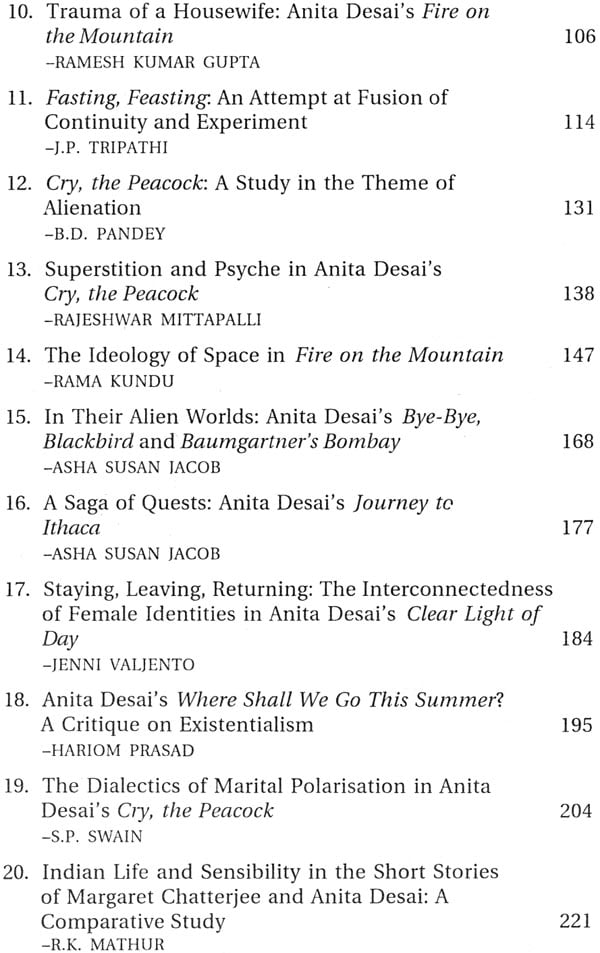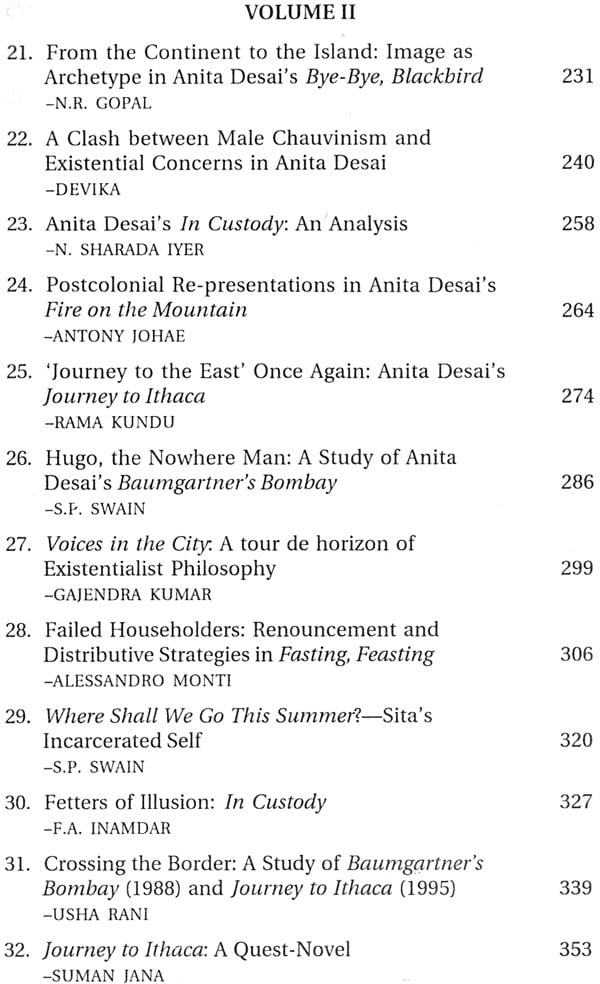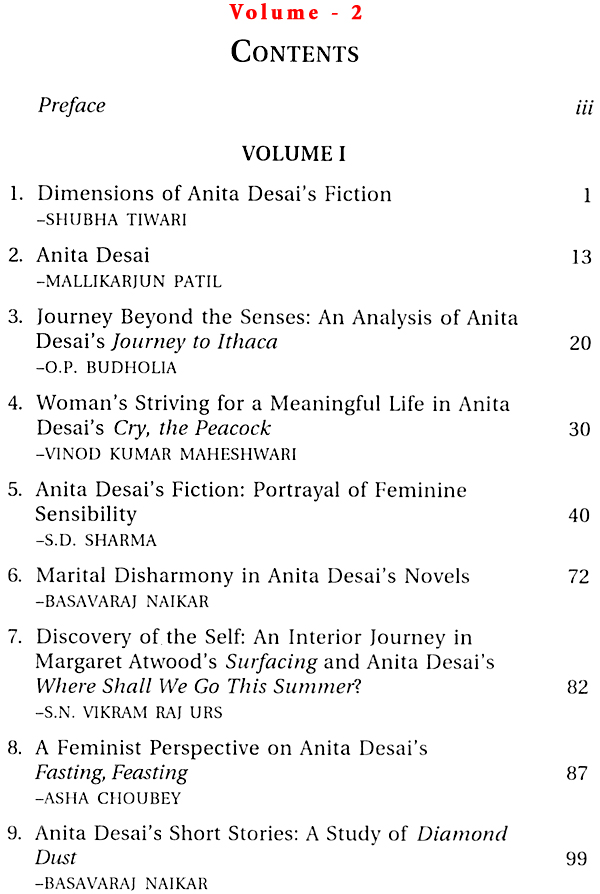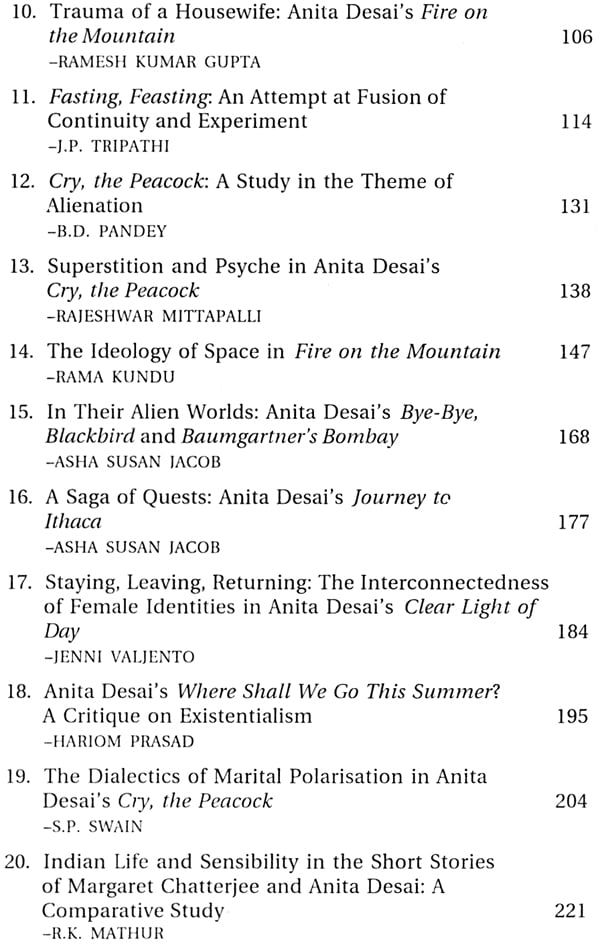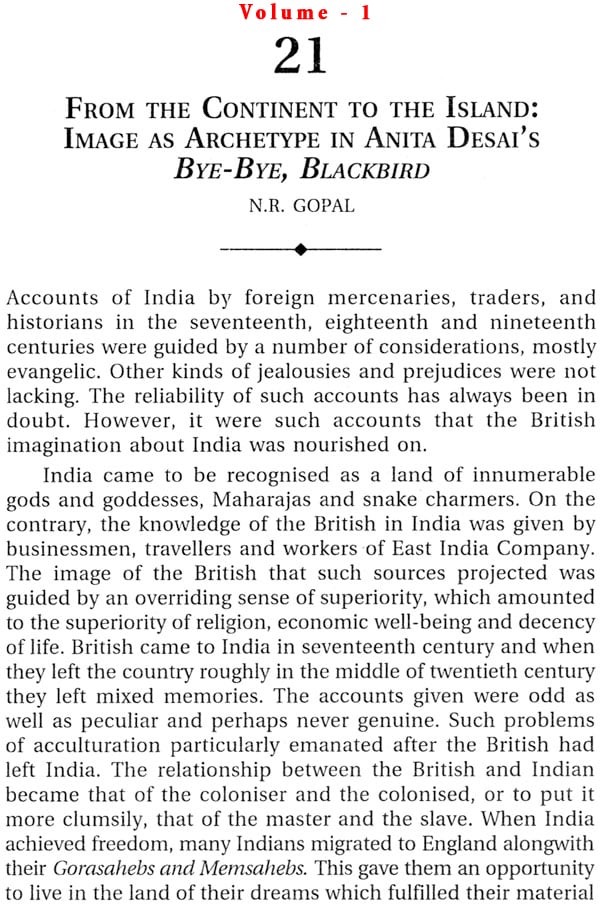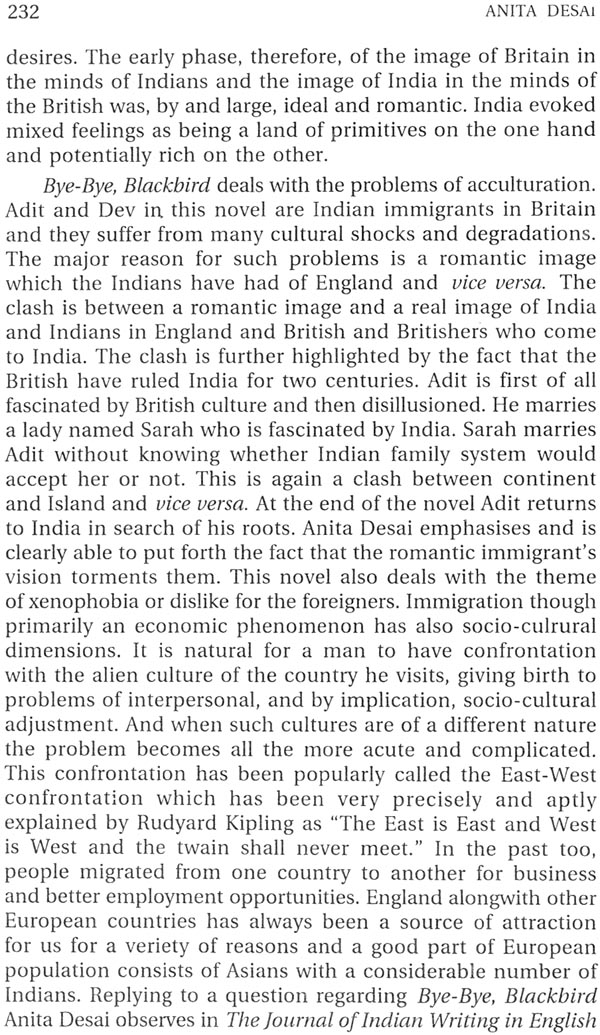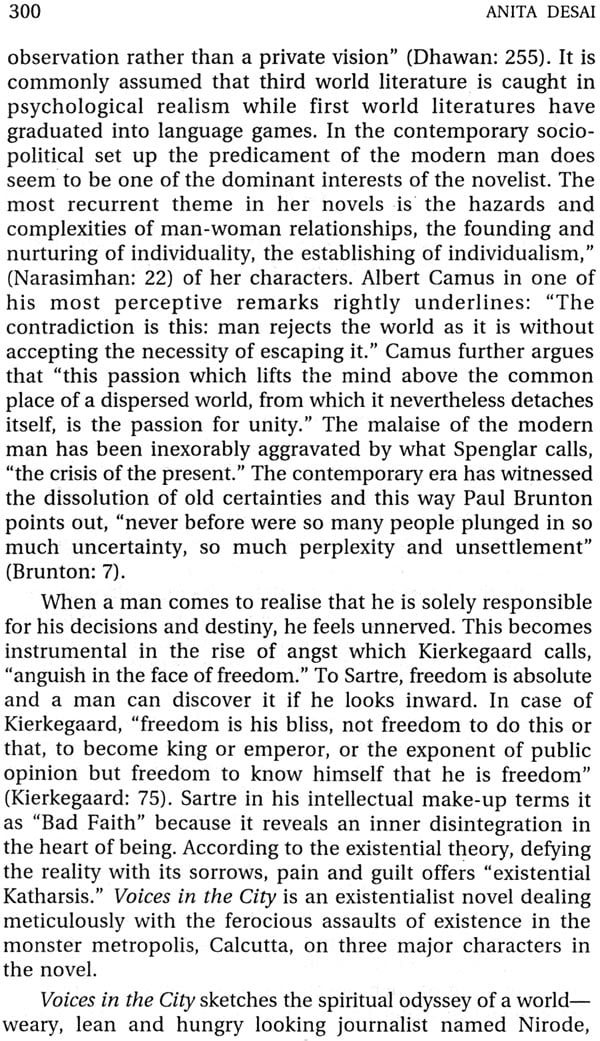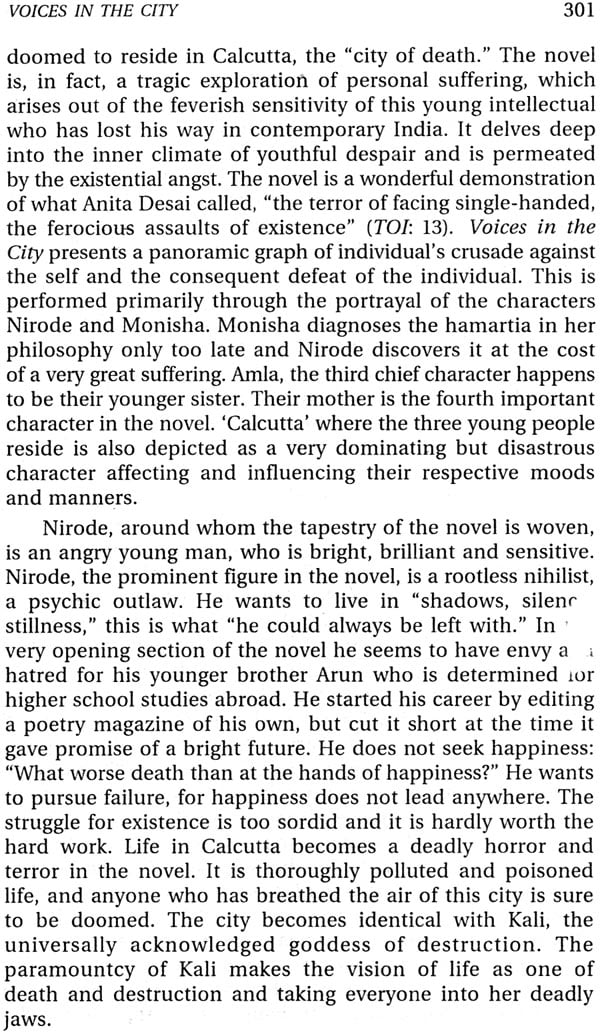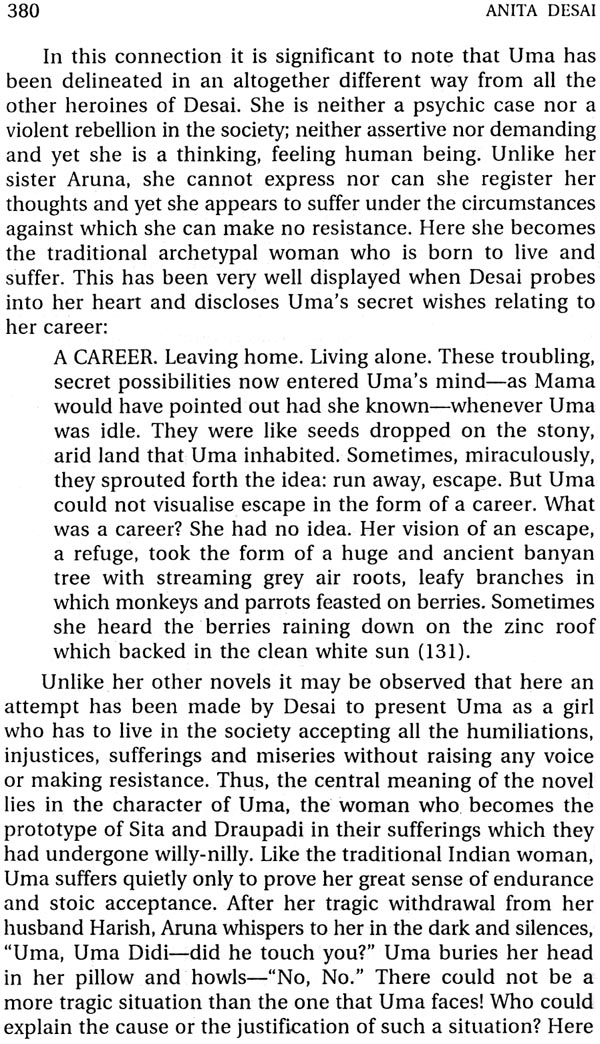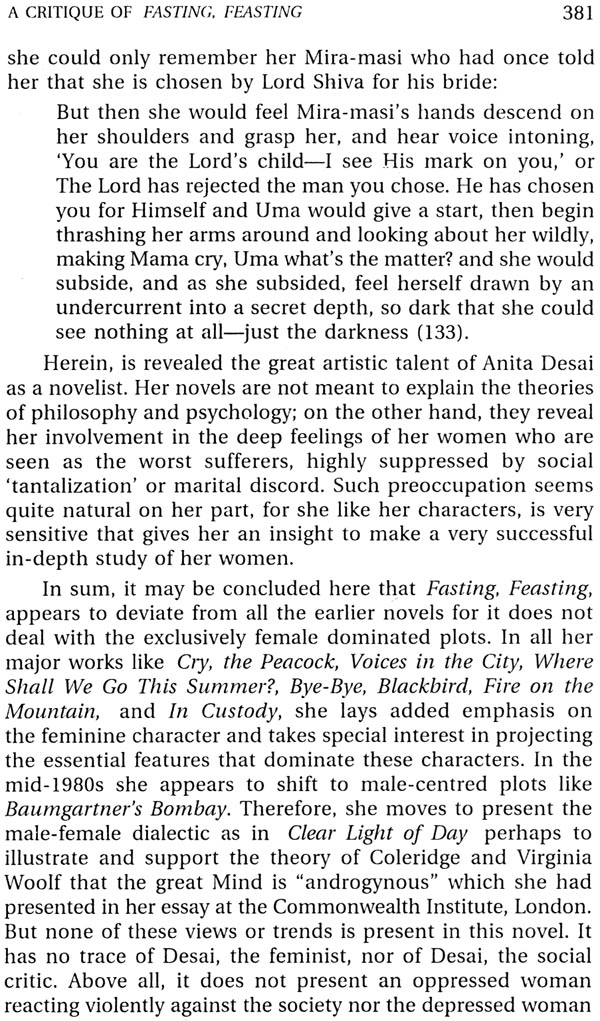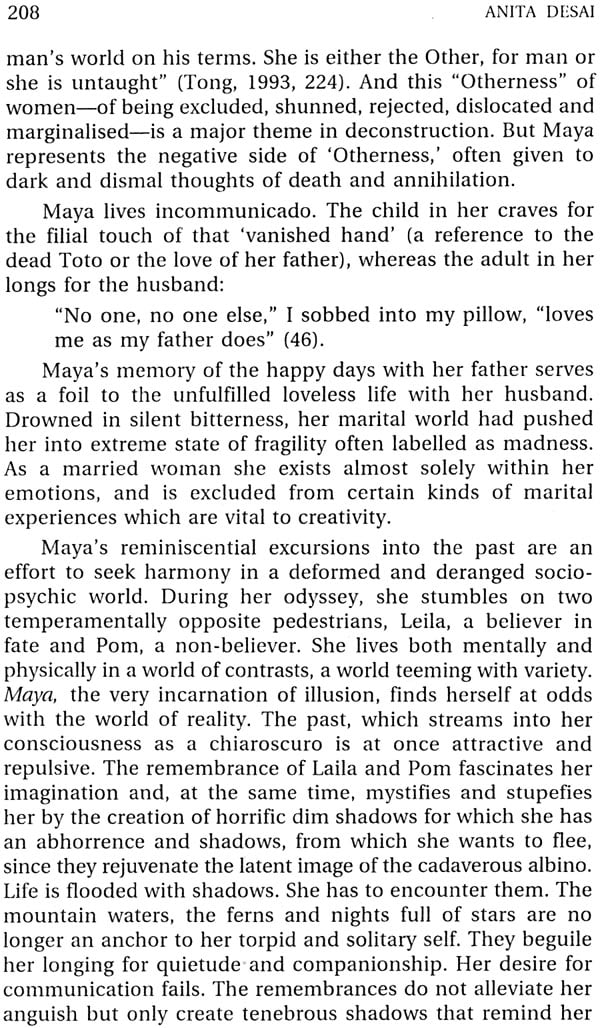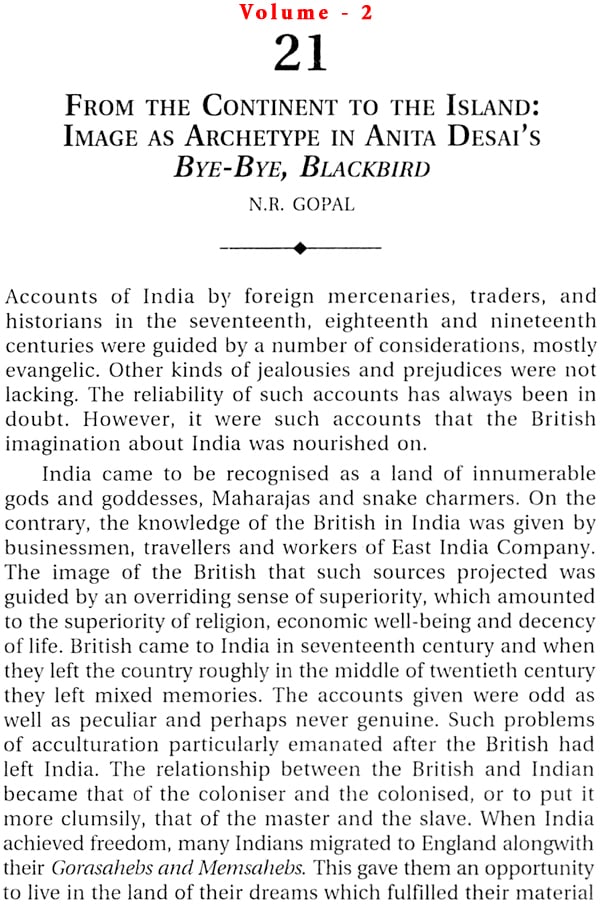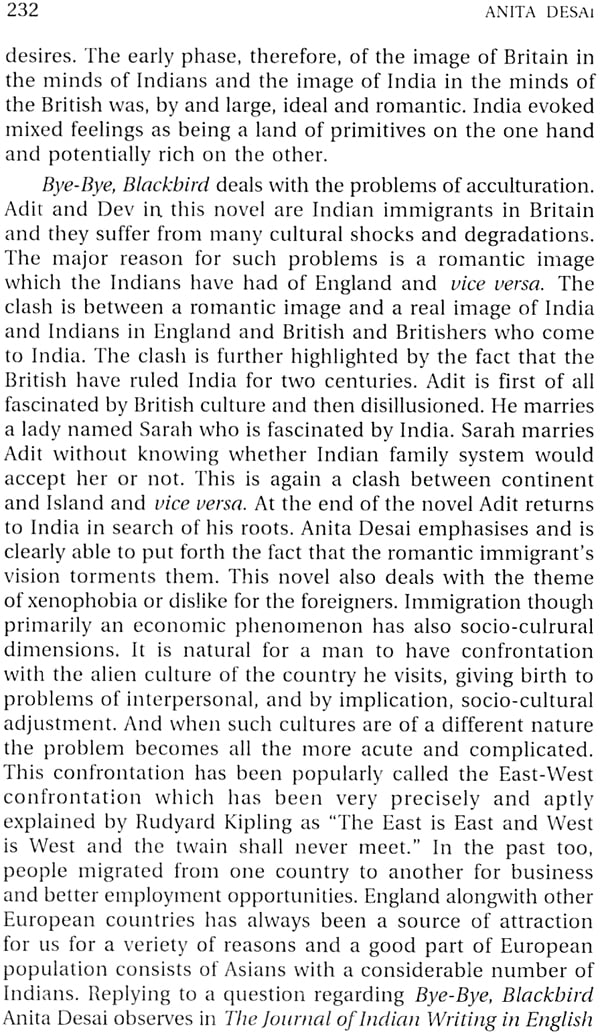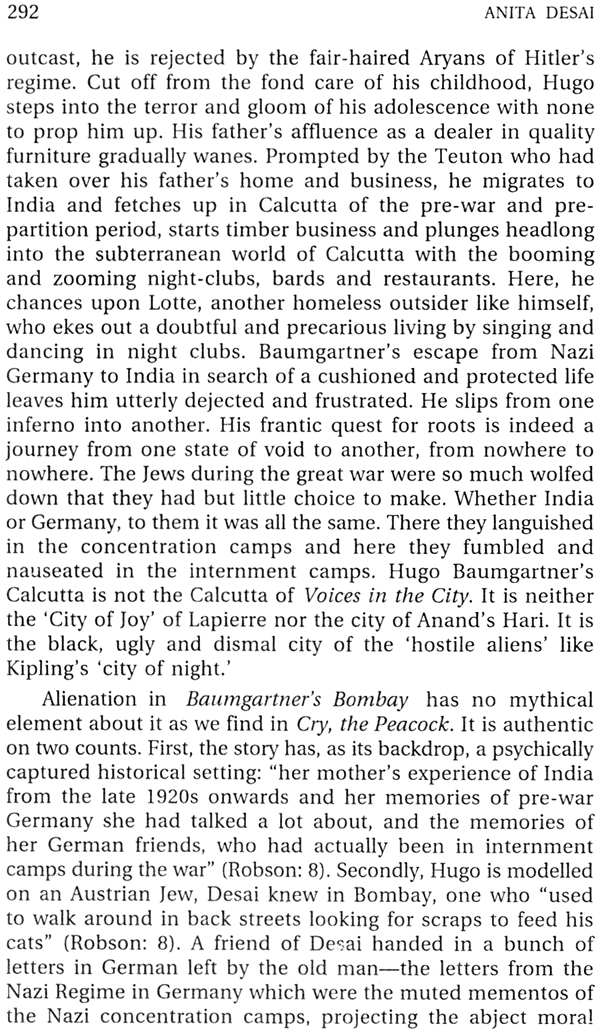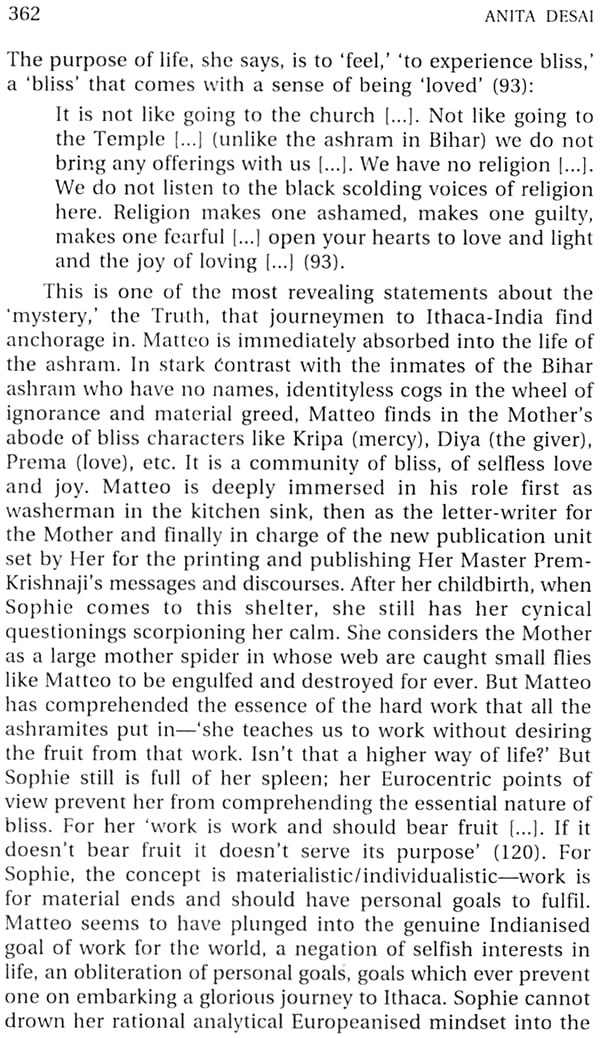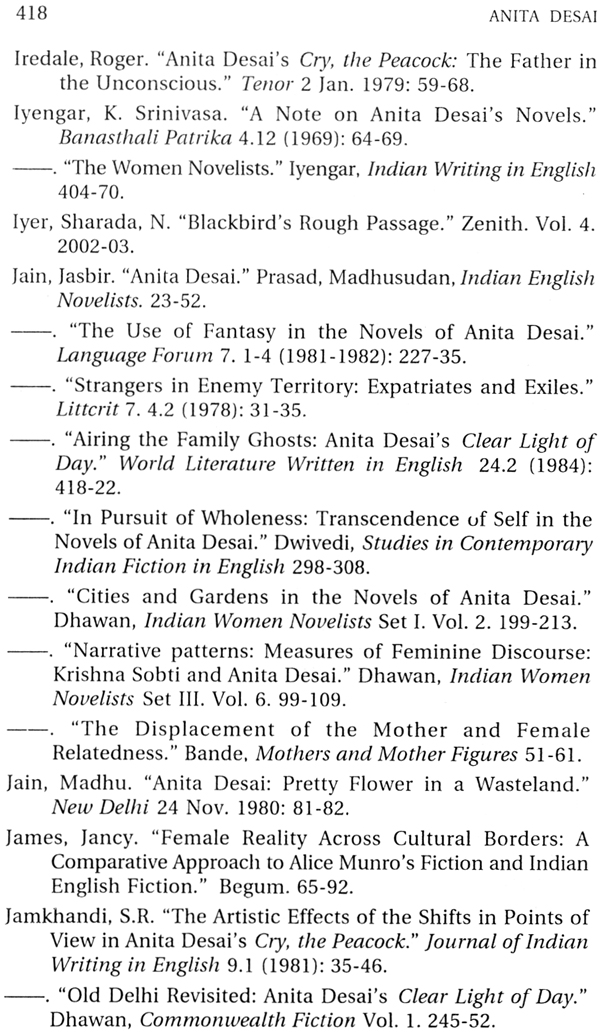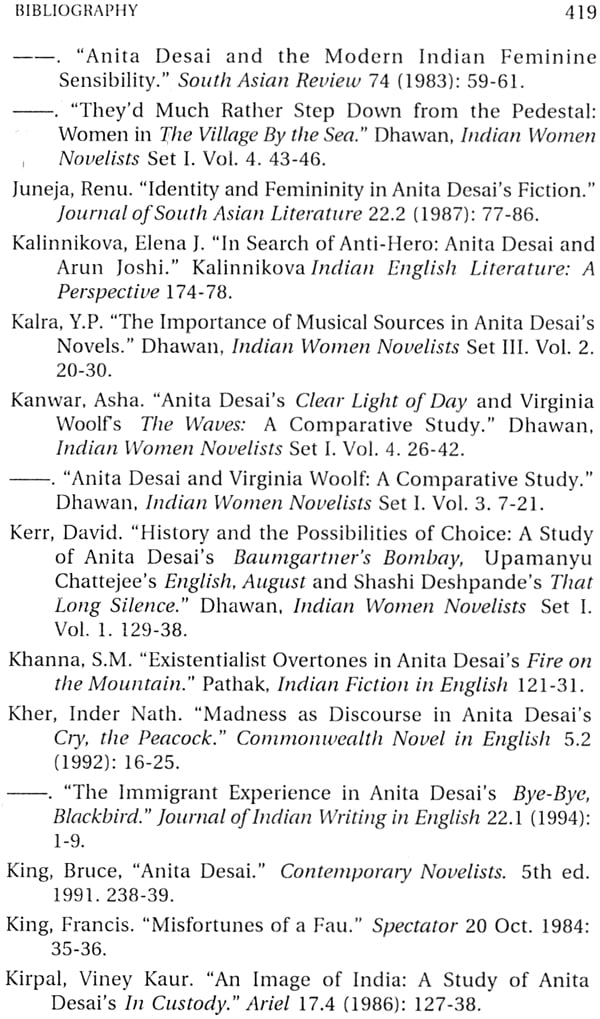
Critical Responses to Anita Desai (Set of 2 Volumes)
Book Specification
| Item Code: | NAS591 |
| Author: | Shubha Tiwari |
| Publisher: | Atlantic Publishers and Distributors Pvt. Ltd. |
| Language: | English |
| Edition: | 2013 |
| ISBN: | 9788126903412 |
| Pages: | 446 |
| Cover: | Hardcover |
| Other Details | 8.50 X 5.50 inch |
| Weight | 800 gm |
Book Description
Anita Desai and her novels have been an enigma for decades. Scholars, critics, researchers and students have never stopped marvelling about supremacy of ‘idea’ over ‘matter’ in the works of this gifted novelist. The philosophical mood, the realization of a grand design, the presence of unsaid, unarticulated realities—all these have forever teased the mind of the discerning reader. In the present volume, Anita Desai has been extensively and intensely probed. As the reader will see, the thrust has been more on psychological and intellectual facets of her fiction, rather than social, cultural or physical areas. This is the trend of criticism these days and it is rightly so. The fine subtleties, the small but significant turns of events, the role of place in the formation of mental scene, the vitality of characters, the force of their personalities, the intricate web of relationships—all these have been examined and expressed in words that are at once easy to understand as well as graceful to aesthetic sense.
Shubha Tiwari, M.A., Ph.D., is Head of the Department of English, A.PS. University, Rewa, Madhya Pradesh. With about thirty published research papers, Dr. Tiwari is also the author of the book, Amitav Ghosh : A Critical Study. She edits the annual literary magazine of her Department, Zenith. She is working for her D.Litt. on Indian Women Novelists, Native Techniques, and Critical Tools. She is the Associate Editor of the International Journal, The Atlantic Literary Review, a reputed and acclaimed critical project. Dr. Tiwari’s areas of interest are recent fiction, interdisciplinary studies, women’s studies, and inspirational literature.
The meaning of an author changes with the passage of time. Shakespeare with post-colonial bombardment has become a racist and so it is with Lamb. We want to see ourselves in a work of literature. Self-centred approach and its appetite in writers as well as readers are amazingly high. We can lead this to a brilliant psychoanalytical discussion on insatiable self. But we will not do so. Instead, let us go'to Anita Desai who has given many of us the satisfaction of readers’ catharsis. With changing decades, we have found newer reflections of ourselves and newer meanings of our existence in the novels of this novelist. Without naming, let me make a sweeping comment that many novelists who began with Desai have exhausted by now. Since 1963, when Maya appeared on the scene, the maya of Desai’s world has kept the readers hooked. So much for the test of time! Maya, Monisha, Nirode, Amla, Bim, Tara, Deven, Sita and others have come closer to us than when they were originally born. Readers have discovered newer bonds with this gallery.
The present collection presents many perspectives on the works of Desai. In the first paper, I have tried to catch the spirit of Desai’s works. The totality of the thing has been aimed at even if it is an impossible task.. It is my own way of making sense out of this mind-boggling mass of literature. It is an effort to see the creative mind at work. It is also an effort to see what the writer herself might not have seen her instincts, that frame of mind that has shaped these novels. The second paper by Mallikarjun Patil is a comment basically on three novels of Desai, namely, Cry, the Peacock, Voices in the City, and Where Shall We Go This Summer? The next contribution from O.P. Budholia is on Journey to Ithaca. It is an effort at explaining the psychological concerns in this novel. It describes Sophie’s actual journey as well as her mental progress. Next comes a paper on Cry, the Peacock. It is interesting to note that the first novel of Anita Desai continues to enjoy a prime position for critics and holds their interest. The paper, somewhat circumscribing women’s area of happiness, nevertheless, gives insight into heightened sensitivity and thereby intensified, agonized self of the protagonist, Maya. In a mega paper, in the name of feminine sensibility, S.D. Sharma gives or better, invents, curious patterns, keeping CCV (Crisis of Conscience and Values) at the centre. It is, as I said, a mega paper, covering many strayed subjects, of which feminine sensibility in only one. Basavaraj Naikar’s paper on marital disharmony makes a good reading. The topic is valid because failed marriages are a repeated thing in Desai’s works. In clear-cut prose, we have an equally convincing discussion.
Comparative studies are worth their effort. Anita Desai, in particular, constantly, reminds the reader of other great writers. I myself remember being fixed by the character of Raka and that of Pearl in The Scarlet Letter by Nathaniel Hawthorne. S.N. Vikram Raj Urs compares two novels, one by Desai, Where Shall We Go This Summer? and Atwood’s Surfacing. The similarities are striking; however, the dissimilarities are glaring too. Asha Choubey tries to give a feminist perspective to Fasting, Feasting. All the female characters and their helplessness have been studied in this paper. Basavaraj Naikar’s paper on Diamond Dust is important because much work has not been done on Desai’s short fiction. We can see that these short stories are miniatures of novels. The same glimpses have been captured in fewer words. Ramesh Kumar Gupta’s paper on a housewife’s trauma in Fire on the Mountain tries to portray Nanda’s loneliness and state of extreme subjectivity. J.P. Tripathi’s paper on Fasting, Feasting focuses on lack of focus in this novel. With widened horizon, what we have in this novel according to Tripathi is more wide and spectacular and less sharp and less pointed. Alienation in Cry, the Peacock, a traditional and accepted theme has been discussed by B.D. Pandey. He has tried to go into the reasons of Maya’s alienated self. Then comes an important paper by Rajeshwar Mittapalli where he has successfully tried a Freudian exposition of Maya’s personality. Maya’s condition is indeed an expression of her suppressed urges. I have been personally impressed by Rama Kundu’s paper on the dimension of space in Desai’s Fire on the Mountain. It is with such papers that we can free this author from biased reading. Space, landscape, locale and settings are an integral part of Desai’s technique and they have been skilfully handled here. In her paper, Asha Susan Jacob connects the theme of alienation in Bye-Bye, Blackbird to Christian theme of original separation when God ousted Adam and Eve from paradise. In her next paper Jacob deals with quest motif in Journey to Ithaca. The quest here is multi layered, she points out. Jenni Valjento has taken up the interconnectedness of the personalities of Bim and Tara in Clear Light of Day. Hariom Prasad’s paper on Where Shall We Go This Summer? is a critique on existentialist philosophy as reflected in this Novel. Sita’s state of mind is such that she fails to see any sense in life. S.P. Swain’s paper on Cry, the Peacock depicts the polarized, estranged selves of Gautama and Maya. The argument, as the reader will see, comes very close to what Mittapalli has said earlier. It only strengthens the thesis that Gautama’s murder is a kind of wish fulfilment for Maya. The last paper in the first Volume compares the short stories of Anita Desai and a less known writer Margaret Chatterjee. The enthusiasm of the paper writer for Chatterjee and his effort to bring credit and recognition to this author is notable.
The second Volume of this critical endeavour on Anita Desai is a proof of her popularity. Her ability to provoke response is immense. The very fact that articles rain on her earliest creations show their lasting value and impact. The first paper in this Volume is on Bye-Bye, Blackbird by N.R. Gopal. It is interesting to see how the image slowly becomes an archetype. While Indian archetype revolves around maharajas, snake charmers, and gods and goddesses, the British one reinforces images of superiority and decency. Devika holds the accepted view of Maya and her ailment. The paper is a probing into Maya’s psyche. N. Sharada Iyer has tried to understand Deven and other characters in Custody. Antony Johae has gone for an intellectual exercise of creating his own meanings as a critic out of Desai’s Fire on the Mountain. The result is a rewarding reading of parallels between post-colonial theories and details of this novel. The next analysis of Journey to Ithaca by Rama Kundu is a fine exposition of Western infatuation for India and its reasons. S.P. Swain makes no hiding in the next paper on Baumgartner’s Bombay regarding utter failure, loneliness and helplessness of Baumgartner. Gajendra Kumar sees Voices in the City as a deliberate delineation of existentialist philosophy. Alessandro Monti with his keen acquaintance with Indian religious practices and symbols goes for construction of parallels between the Indian myths and the happenings in the novel. S.P. Swain with his effective words builds the character of Sita on psychological realities. F.A. Inamdar deals with illusions and their shattering as described in Custody. Quest, crossing limits and journey are the main motifs from which Usha Rani explains the two novels—Baumgartner’s Bombay and Journey to Ithaca. Suman Jana again goes for quest theme in Journey to Ithaca. Obviously the novel demands this treatment. M.Q. Khan’s critique on Fasting, Feasting is an attempt to show prejudices nurtured against a girl in a Hindu household. Asha Choubey aptly takes up an upcoming theme in Indian fiction in English, mother-daughter drift. Both Manju Kapur in Difficult Daughters and Anita Desai in Fasting, Feasting undo the false myth of a mother’s unconditional support to her daughter. This relationship wrongly deified for long is actually based on selfish motives just like all other relationships in the world. Usha Rani, in my opinion, has tried to impose a sweet, sweet attitude on Fasting, Feasting simply because the situations depicted in the novel skilfully smother any desire or dream of Uma. The novel shows the tragedy of being a female, an ordinary, and average-looking female in a society that loves and promotes sadistic attitudes for such creatures. Even parents are party to such arrangements. Desai’s total identification with her female characters is one of the many outstanding reasons that account for her brilliance as a novelist.
I wish to express my deep felt thanks to Dr K.R. Gupta, Chairman, Atlantic Publishers and Distributors for bringing out these Volumes on Anita Desai and thereby upgrading the critical material available on this important novelist.
**Contents and Sample Pages**

